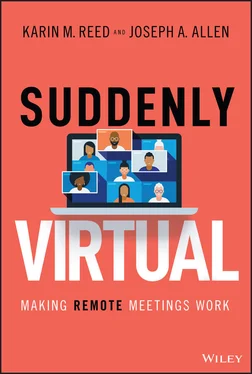183 179
184 180
185 181
186 183
187 184
188 185
189 186
190 187
191 188
192 189
193 190
194 191
195 192
196 193
197 194
198 195
199 196
200 197
201 198
202 199
203 200
204 201
205 203
206 204
207 205
208 206
209 207
210 208
211 209
212 210
213 211
214 212
215 213
216 214
217 215
218 216
219 217
220 218
221 219
222 220
223 221
224 222
225 223
226 224
227 225
228 226
229 227
230 228
231 229
232 230
233 231
234 232
235 233
236 234
237 235
238 236
239 237
240 238
241 239
242 240
243 241
244 242
245 243
246 244
247 245
248 246
249 247
250 248
251 249
252 250
253 251
254 252
255 253
256 254
257 255
258 256
259 257
260 258
261 259
262 260
263 261
264 262
265 263
266 264
267 265
268 266
269 267
270 269
271 270
272 271
273 272
274 273
275 274
276 275
277 276
278 277
279 278
280 279
281 280
282 281
283 282
284 283
285 284
286 285
287 286
288 287
289 288
SUDDENLY VIRTUAL
Making Remote Meetings Work
KARIN M. REED
JOSEPH A. ALLEN

Copyright © 2021 by John Wiley & Sons, Inc. All rights reserved.
Published by John Wiley & Sons, Inc., Hoboken, New Jersey.
Published simultaneously in Canada.
No part of this publication may be reproduced, stored in a retrieval system, or transmitted in any form or by any means, electronic, mechanical, photocopying, recording, scanning, or otherwise, except as permitted under Section 107 or 108 of the 1976 United States Copyright Act, without either the prior written permission of the Publisher, or authorization through payment of the appropriate per‐copy fee to the Copyright Clearance Center, Inc., 222 Rosewood Drive, Danvers, MA 01923, (978) 750‐8400, fax (978) 646‐8600, or on the Web at www.copyright.com. Requests to the Publisher for permission should be addressed to the Permissions Department, John Wiley & Sons, Inc., 111 River Street, Hoboken, NJ 07030, (201) 748‐6011, fax (201) 748‐6008, or online at www.wiley.com/go/permissions.
Limit of Liability/Disclaimer of Warranty: While the publisher and author have used their best efforts in preparing this book, they make no representations or warranties with respect to the accuracy or completeness of the contents of this book and specifically disclaim any implied warranties of merchantability or fitness for a particular purpose. No warranty may be created or extended by sales representatives or written sales materials. The advice and strategies contained herein may not be suitable for your situation. You should consult with a professional where appropriate. Neither the publisher nor author shall be liable for any loss of profit or any other commercial damages, including but not limited to special, incidental, consequential, or other damages.
For general information on our other products and services or for technical support, please contact our Customer Care Department within the United States at (800) 762‐2974, outside the United States at (317) 572‐3993, or fax (317) 572‐4002.
Wiley publishes in a variety of print and electronic formats and by print‐on‐demand. Some material included with standard print versions of this book may not be included in e‐books or in print‐on‐demand. If this book refers to media such as a CD or DVD that is not included in the version you purchased, you may download this material at http://booksupport.wiley.com. For more information about Wiley products, visit www.wiley.com.
Library of Congress Cataloging‐in‐Publication Data is Available:
ISBN 9781119793670 (Hardback)
ISBN 9781119793687 (ePub)
ISBN 9781119793694 (epdf)
COVER DESIGN: PAUL McCARTHY
COVER ART: © GETTY IMAGES | RLT_IMAGES
AUTHOR PHOTOS: COURTESY OF THE AUTHORS
For our families who allowed us to disappear into our writing to get this book quickly to our readers who are desperately seeking answers in this “Suddenly Virtual” world.
Joe: For Joy, Karen, Rachel, Alice, and Julia
Karin: For Shawn, Hayden, and Jackson
Preface: The Collision and Convergence of Two Areas of Expertise
In mid‐March 2020, the world of work transformed before our eyes. While essential workers continued to valiantly do their jobs in the face of a global pandemic, the vast majority of corporate offices closed their brick‐and‐mortar locations and moved to entirely remote operations to protect the lives of their employees and loved ones. Suddenly, so‐called knowledge workers were working from home, often in environments that were never designed for this new purpose. Important sales calls were taking place from the back porch. Training was being conducted virtually from dining room tables. Teams were navigating a dispersed workplace through the camera lenses of their home computers, smartphones, and tablets.
It was about a week before the “stay‐at‐home” orders swept across the United States that Dr. Joseph Allen and Karin Reed crossed paths. They were both working as subject matter experts for Logitech, the market leader in video collaboration tools, but they brought very different experiences and insights to the table.
Joe had been studying workplace meetings as an academic for over a decade, publishing more than 100 articles, book chapters, and books on the topic in academic outlets. He edited two volumes related to meeting science, including The Cambridge Handbook of Meeting Science and Research on Managing Groups and Teams: Managing Meetings in Organizations . As a recognized thought leader in this area, his work highlights the science‐based best practices for workplace meetings. He provides consulting services for a variety of leaders and organizations toward the optimization of their workplace meetings.
Karin had been teaching on‐camera communication skills for almost a decade through her communication training firm, Speaker Dynamics. After an Emmy‐award winning career as a broadcast journalist and professional spokesperson, she developed a methodology to help business professionals be effective communicators when speaking to a camera, be it in the studio or in front of a laptop. Her first book, On‐Camera Coach: Tools and Techniques for Business Professionals in a Video‐Driven World , debuted as a #1 Hot New Release in Business Communications in 2017.
On March 11, 2020, Joe and Karin were asked to bring their expertise to bear as featured panelists for a Logitech webinar titled Rethinking the Modern Meeting . Little did they know how much the “modern meeting” would change within weeks, even within days of that early March webinar. The seismic shift would have broad implications for both of them – a veritable playground of new meeting science hypotheses to explore for Joe and an overnight explosion of business for Karin and her team from clients who were clamoring to get comfortable communicating by webcam alone.
The shift to virtual meetings was sudden and often traumatic for businesses across all industries. At first, rather than focusing on what would work best, businesses simply focused on what worked now . And what worked now was closing up the office and being suddenly virtual in nearly every meeting, often without the tools, the training, or the expertise to optimize the new “kitchen table” office. As weeks turned into months, though, businesses started to be more purposeful in the tools they used and the approach they took but still relied mostly upon gut feeling and perhaps trial and error.
Читать дальше













